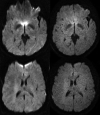Diffusion MR imaging in multiple sclerosis: technical aspects and challenges
- PMID: 17353305
- PMCID: PMC7977828
Diffusion MR imaging in multiple sclerosis: technical aspects and challenges
Abstract
Diffusion tensor (DT) MR imaging has frequently been applied in multiple sclerosis (MS) because of its ability to detect and quantify disease-related changes of the tissue microstructure within and outside T2-visible lesions. DT MR imaging data collection places high demands on scanner hardware and, though the acquisition and postprocessing can be relatively straightforward, numerous challenges remain in improving the reproducibility of this technique. Although there are some issues concerning image quality, echo-planar imaging is the most widely used acquisition scheme for diffusion imaging studies. Once the DT is estimated, indexes conveying the size, shape, and orientation of the DT can be calculated and further analyzed by using either histogram- or region-of-interest-based analyses. Because the orientation of the DT reflects the orientation of the axonal fibers of the brain, the pathways of the major white matter tracts can also be visualized. The DT model of diffusion, however, is not sufficient to characterize the diffusion properties of the brain when complex populations of fibers are present in a single voxel, and new ways to address this issue have been proposed. Two developments have enabled considerable improvements in the application of DT MR imaging: high magnetic field strengths and multicoil receiver arrays with parallel imaging. This review critically discusses models, acquisition, and postprocessing approaches that are currently available for DT MR imaging, as well as their limitations and possible improvements, to provide a better understanding of the strengths and weaknesses of this technique and a background for designing diffusion studies in MS.
Figures






Similar articles
-
Diffusion tensor MR imaging.Neuroimaging Clin N Am. 2009 Feb;19(1):37-43. doi: 10.1016/j.nic.2008.08.001. Neuroimaging Clin N Am. 2009. PMID: 19064198 Review.
-
Diffusion tensor MRI in multiple sclerosis.J Neuroimaging. 2007 Apr;17 Suppl 1:27S-30S. doi: 10.1111/j.1552-6569.2007.00133.x. J Neuroimaging. 2007. PMID: 17425731 Review.
-
Diffusion-weighted MR of the brain: methodology and clinical application.Radiol Med. 2005 Mar;109(3):155-97. Radiol Med. 2005. PMID: 15775887 Review. English, Italian.
-
Intrinsic damage to the major white matter tracts in patients with different clinical phenotypes of multiple sclerosis: a voxelwise diffusion-tensor MR study.Radiology. 2011 Aug;260(2):541-50. doi: 10.1148/radiol.11110315. Epub 2011 Jun 14. Radiology. 2011. PMID: 21673227
-
Occult tissue damage in patients with primary progressive multiple sclerosis is independent of T2-visible lesions--a diffusion tensor MR study.J Neurol. 2003 Apr;250(4):456-60. doi: 10.1007/s00415-003-1024-1. J Neurol. 2003. PMID: 12700912
Cited by
-
The Network Modification (NeMo) Tool: elucidating the effect of white matter integrity changes on cortical and subcortical structural connectivity.Brain Connect. 2013;3(5):451-63. doi: 10.1089/brain.2013.0147. Brain Connect. 2013. PMID: 23855491 Free PMC article.
-
Exploring the brain's structural connectome: A quantitative stroke lesion-dysfunction mapping study.Hum Brain Mapp. 2015 Jun;36(6):2147-60. doi: 10.1002/hbm.22761. Epub 2015 Feb 5. Hum Brain Mapp. 2015. PMID: 25655204 Free PMC article.
-
DTI Measurements in Multiple Sclerosis: Evaluation of Brain Damage and Clinical Implications.Mult Scler Int. 2013;2013:671730. doi: 10.1155/2013/671730. Epub 2013 Mar 31. Mult Scler Int. 2013. PMID: 23606965 Free PMC article.
-
High field MRI in the diagnosis of multiple sclerosis: high field-high yield?Neuroradiology. 2009 May;51(5):279-92. doi: 10.1007/s00234-009-0512-0. Epub 2009 Mar 11. Neuroradiology. 2009. PMID: 19277621 Review.
-
Magnetic resonance monitoring of lesion evolution in multiple sclerosis.Ther Adv Neurol Disord. 2013 Sep;6(5):298-310. doi: 10.1177/1756285613484079. Ther Adv Neurol Disord. 2013. PMID: 23997815 Free PMC article.
References
-
- Rovaris M, Gass A, Bammer R, et al. Diffusion MRI in multiple sclerosis. Neurology 2005;65:1526–32 - PubMed
-
- Horsfield MA, and Jones DK. Applications of diffusion-weighted and diffusion tensor MRI to white matter diseases—a review. NMR Biomed 2002;15:570–77 - PubMed
-
- Sotak CH. The role of diffusion tensor imaging in the evaluation of ischemic brain injury—a review. NMR Biomed 2002;15:561–69 - PubMed
-
- Carr HY, Purcell EM. Effects of diffusion on free precession in nuclear. Phys Rev 1954;94:630–38
-
- Torrey HC. Bloch equations with diffusion terms. Phys Rev 1956;104:563–65
Publication types
MeSH terms
Grants and funding
LinkOut - more resources
Full Text Sources
Other Literature Sources
Medical
